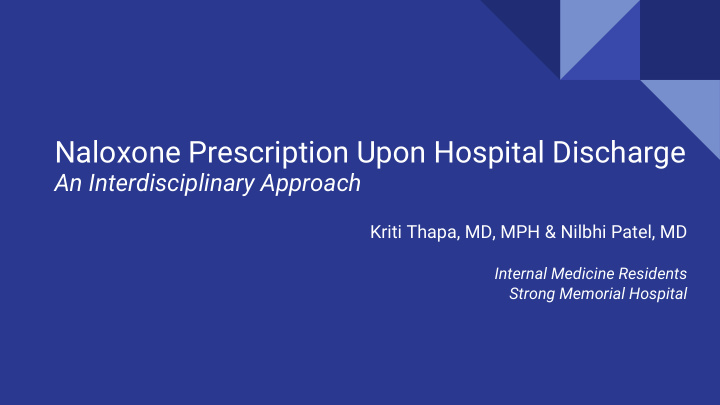



Naloxone Prescription Upon Hospital Discharge An Interdisciplinary Approach Kriti Thapa, MD, MPH & Nilbhi Patel, MD Internal Medicine Residents Strong Memorial Hospital
Project Background ● Center for Disease Control & Prevention and the Surgeon General have issued guidelines recommending co-prescription of naloxone with opiates for a subset of patients ○ Those on opiate pain medications ○ Those with risk factors for opiate overdose ● Naloxone prescribing for high-risk patients is a risk mitigation strategy. ● Multidisciplinary quality improvement pilot project ○ Aim: to increase access to naloxone in the community by identifying patients at risk of an OAE (opioid adverse event) upon hospital discharge , targeting staff and patient education , and increasing the number of naloxone prescriptions .
)*$4*"E(2'+,*-./-$&L(K/(*-+=(."/-'&/(-?'&/-A-,"/-$& @"/'4$*H(K(*',$EE'&?"/-$&(A*$E( /3'(@2@(D>-?'#-&'(A$*()*'+,*-:-&4( M.-$-?+(A$*(@3*$&-,()"-&L( ! 3-+/$*H($A(+>:+/"&,'(":>+'( ! ,$F"?E-&-+/*"/-$&($A($.-$-?+("&?( :'&N$?-"N'.-&'+( ! .*'+,*-./-$&($A(OPQ(E$*.3-&'( E-##-4*"E('J>-B"#'&/+(R88STU?"H( ! .*'B-$>+(3-+/$*H($A("&($B'*?$+'( ! *-+=(A$*(*'/>*&-&4(/$(?$+'+($A( $.-"/'+("A/'*("(.'*-$?($A( ":+/-&'&,'( ! ."/-'&/+(G-/3("(+-4&-A-,"&/( *'?>,/-$&(-&($.-"/'(?$+'(>.$&( ?-+,3"*4'(
Program Evaluation ● Data was obtained from the hospital outpatient pharmacy records of naloxone nasal spray prescriptions at the time of discharge ● Patients who received naloxone after program implementation: ○ mostly male (56%, n=36) ○ mean age 51 ± 15 years ○ median hospital length of stay was 6 days ○ 59% were on chronic opioids prior to admission ● Co-payments ○ 85.9% of patients had a co-pay ranging from zero to one dollar ○ Seven patients (10.9%) had a co-pay ranging from two to thirty-five dollars and two patients ○ 3% had a co-pay of higher than thirty-five dollars
)*$4*"E(SB"#>"/-$&
Limitations Future Projects ● At-risk patients who were not included: ● Expanding the intervention to ○ decreased opioid clearance and metabolism (ie: visiting nursing services, local nursing homes and long-term care liver cirrhosis or chronic kidney disease) facilities ○ discharged to skilled nursing facilities and thus already have access to naloxone ● Automating the identification of ○ preferred to use an external pharmacy high-risk patients in the ○ receiving opioids for cancer-related pain computerized physician order entry system and electronic ● Inability to measure how often naloxone is being used after discharge, partly due to limited access to external medical record databases ● Evaluation of the efficacy of these ● Ability to study how our intervention of increasing educational interventions naloxone in the community is impacting the number of ED visits and deaths related to OAE
Acknowledgments ● Meghan Train, DO ● Nicole M. Acquisto, Pharm.D., FCCP, BCCCP ● Marissa Pasho, NP References 1. Scholl L, Seth P, Kariisa M, Wilson N, Baldwin G. Drug and Opioid-Involved Overdose Deaths –UnitedStates, 2013-2017. Morbidity and Mortality Weekly Report (MMWR) Report. ePub: 21 December 2018. 2. Singer, Patti. Monroe County opioid overdose deaths up more than 200 percent in two years. Democrat and Chronicle. 3 July 2018 3. Dunne RB. Prescribing naloxone for opioid overdose intervention. Pain Management. 2018; 8(3): 197–2084.Dowell D, Haegerich TM, Chou R. CDC Guideline for Prescribing Opioids for Chronic Pain. Morbidity and Mortality Weekly Report (MMWR) Recommendations and Reports. 18 March 2016; 65(1):1–495. 4. U.S. Department of Health and Human Services (HHS), Office of the Surgeon General.Facing Addiction in America: The Surgeon General’s Spotlight on Opioids. Available at: https://www.surgeongeneral.gov/priorities/opioid-overdose-prevention/naloxone-advisory.html.Accessed September 2018. 5. Zschoche JH, Nesbit S, Murtaza U, et al. Development and implementation of procedures for outpatient naloxone prescribing at a large academic medical center. American Journal of Health-System Pharmacy. Nov 2018;75 (22): 1812-18207. 6. WinogradR, Davis C, Niculete M., Oliva E,Martielli R (2017). Medical providers’ knowledge and concerns about opioid overdose education and take-home naloxone rescue kits within Veterans Affairs health care medical treatment settings. Substance Abuse. 2017; 38(2):135-1408. 7. Monroe County Department of Public Health. Opioid Overdose Prevention Training (Narcan/Naloxone). Available at:https://www.monroecounty.gov/opioids/.Accessed September 20189. 8. Walley AY, Xuan Z, Hackman HH, et al. Opioid overdose rates and implementation of overdose education and nasal naloxone distribution in Massachusetts: interrupted time series analysis. BMJ. 2013; 346 :f17410. 9. Coffin PO, Behar E, Rowe C, et al. Nonrandomized InterventionStudy of Naloxone Coprescription for Primary Care Patients Receiving Long-Term Opioid Therapy for Pain. Ann Intern Med. 2016;165:245-25211. 10. New York State Department of Health. Naloxone Co-payment Assistance Program (N-CAP). Available at:https://www.health.ny.gov/publications/9826.pdf.Accessed September 201812. 11. Vu Q, Beselman A, Monolakis J, Wang A, Rastegar D. Risk factors for opioid overdose among hospitalized patients.Journal of Clinical Pharmacy and Therapeutics. 201813. 12. Doe-Simkins M, Quinn E, Xuan Z, et al. Overdose rescues by trained and untrained participants and change in opioid use among substance-using participants in overdose education and naloxone distribution programs: a retrospective cohort study.BMC Public Health. 2014; 14(1) 13. Van SP, YaoAL, Tang T, et al. Implementing an Opioid Risk Reduction Program in the Acute Comprehensive Inpatient Rehabilitation Setting. Arch Phys Med Rehabil. Aug 2019;100(8):1391-1399. 14. Braithwaite V, Nolan S. Hospital-Based Addiction Medicine Healthcare Providers: High Demand, Short Supply. Available at: https://journals.lww.com/journaladdictionmedicine/Abstract/2019/08000/Hospital_Based_Addiction_Medicine_Healthcare.1.aspx. Accessed October 2019.
Recommend
More recommend